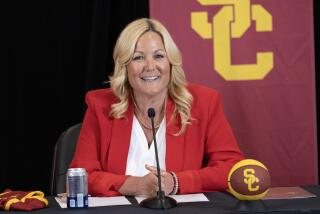Putting Its Money Where Its Plans Are
- Share via
That sound you may have heard emanating from Cal State Northridge the other day was one shoe dropping.
It made a big splash, in the newspapers and on campus. The school’s physical education instructors and coaches have unanimously recommended that the school step up to the NCAA Division I level in all sports except football, beginning about 1990.
Suddenly, Pete Cassidy, the men’s basketball coach, is being asked when he’s going to make the Final Four.
Cassidy just grins. He’s still waiting for the other shoe to drop. The one with the money in it.
Don’t take Cassidy wrong. He’d be the last one to discourage a move to the big time. But he’s not exactly ready to invite Bob Knight’s Hoosiers over to Northridge for a game. Not yet.
“All this talk of Division I is fine,” Cassidy says, “but I want to know what the nuts and bolts of it are. We’ve talked about it, now let’s figure out how we’re going to do it. We are going to need a lot more in the way of financial resources. It must come from the top. We are going to need increased staff. We are going to have to raise a lot more money.
“What we must do, if we want to bring in teams from around the country, is to build an arena. We have close to 30,000 students on this campus. By the year 2000, we should have well over two million people in this area. To have no arena and no plans for one is ludicrous. Somebody has got to show some foresight and come up with some plans for one. It’s not going to get any less expensive in the future.
“I remember when Loyola had a cracker-box gym. They couldn’t recruit. They were losing players left and right. What we have now is a very nice gymnasium. Very nice. But it’s small. It seats 3,000 people. Now how are we going to compete in recruiting with only a 3,000-seat gymnasium, built back in 1963 for a student body of 8,000?”
Cassidy remembers those days. He began in the program two decades ago, serving as an assistant to then head man Jerry Ball at what was then Valley State College.
Cassidy is in his 16th year as head coach. And he’s more than ready to see the program reach its potential.
“We’re going to struggle early in Division I,” he says, “but we’ve got to start somewhere. More and more schools are dropping out of Division II, and it’s getting harder to find opponents.”
Is he talking about finding a new opponent, like say UCLA?
“They’re playing Long Beach State,” Cassidy says. “Ten years ago, nobody thought that would happen. So why not? The community should be thrilled that this is the type of team we want to bring in. But it’s not just a case of, ‘Poof, it’s going to come out of thin air.’ ”
Nope, it’s going to take money. Lots of it. Forget the arena for a moment. Let’s just talk scholarships. And recruiting. And a staff.
Currently, Cassidy has about $17,000 in scholarship money--a little more than three full scholarships--around $10,000 he is able to raise for recruiting, and about $10,000 from student funds for a total of nearly $40,000.
To compete in Division I, he would eventually like to have 15 full scholarships ($75,000), perhaps $25,000 for recruiting and another $30,000 to $40,000 for expenses such as travel. That’s a total of $140,000, more than three times the current budget.
And that’s not even considering Cassidy’s dream arena.
“Sure we could go Division I and be 2-26 every year,” Cassidy says, “but I don’t want an early grave. I want some rewards. I don’t think the university is prepared to go 2-26. There’s no question we are not going to get all we need right away, but somebody better have some plans for the future.”
James W. Cleary, CSUN president, has not commented on the faculty recommendation. He has indicated he will study it for the next few months before forming final judgments.
The proposal sounded exciting. But when Cleary starts searching for those nuts and bolts, starts looking at the practicality of it all, starts talking dollars and cents . . . well, I wouldn’t hold my breath waiting for that other shoe to drop.
More to Read
Get our high school sports newsletter
Prep Rally is devoted to the SoCal high school sports experience, bringing you scores, stories and a behind-the-scenes look at what makes prep sports so popular.
You may occasionally receive promotional content from the Los Angeles Times.






